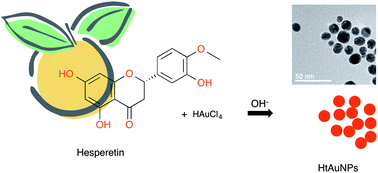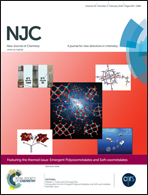Biogenic approaches using citrus extracts for the synthesis of metal nanoparticles: the role of flavonoids in gold reduction and stabilization†
Abstract
Synthesis of nanoparticles free from toxic chemicals and solvents is highly seen for large-scale production processes, particularly for use in biomedical/biotechnological applications. So far, although several methods for synthesis of metal nanoparticles using citrus extracts have been described, none of them clarify which compounds are responsible for both reduction and stabilization of NPs. Here we report the role of citrus flavonoids, hesperidin, hesperetin, rutin, naringenin, quercetin and diosmin, in the synthesis of gold nanoparticles (AuNP) at room temperature. Only in the presence of the citrus flavonoids, diosmin (Dm), and hesperetin (Ht), the reduction of HAuCl4 in concentrations as high as 7 mM under alkaline conditions yielded concentrated and self-stabilized suspensions of uniform spherical nanoparticles with a narrow size distribution. We went further and focused on Ht, the most abundant flavonoid aglycone from citrus fruits known for its medicinal properties. HtAuNPs were characterized using high-resolution transmission electron microscopy, dynamic light scattering, X-ray photoelectron spectrometry and UV-Vis spectrophotometry. The NPs remained stable for months without significant changes in their shape and optical properties. Theoretical calculations using density functional theory were used to identify the functional groups involved in the electron transfer from the Ht molecules to gold, which seems to be the consequence of an initial complexation, leading to the reduction of Au3+ ions into Au0. Besides, this procedure provides a one-pot method, showing potential for large-scale.


 Please wait while we load your content...
Please wait while we load your content...